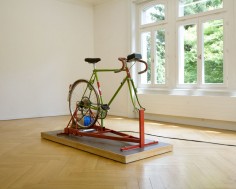JÜRG LEHNI
hertz

source: juerglehni
& Raphael Hefti
2009
Hertz is an installation that creates a scenario of public engagement, by inviting the visitor to ride a bicycle that produces enough energy to run a low-power TV station, broadcasting a signal out into the local vicinity of the museum.
.
.
.
.
.
.
.
source: humanpractice2012blogspot
「これはテレビのシグナルを発信させる自転車です。当時スイスではアナログ放送が終わって、デジタル放送に切り替わった時期でした。この自転車をこぐと違法にテレビの電波を発信して、別の部屋にあるテレビが映るという仕掛けです。これはつまり、『誰かに何かをやらせる』というアイディアで、何も考えていないのに勝手に違法行為をさせてしまうという試みが面白いと思いました。」
.
.
.
.
.
.
.
source: juerglehni
Juerg-Lehni
Jürg Lehni works collaboratively across disciplines, dealing with the nuances of technology, tools and the human condition. His works often take the form of platforms and scenarios for production, such as the drawing machines Hektor, Rita and Viktor, as well as software-based structures and frameworks, including Paper.js, Scriptographer and Vectorama.org.
Lehni has shown work internationally in group and solo shows at the MoMA New York, Walker Art Center, Centre Pompidou, Institute of Contemporary Arts London, Victoria and Albert Museum, Design Museum London, Kunsthalle St. Gallen, etc. In 2014, his work Viktor has been acquired by the SFMOMA for their collection.
He runs an independent practise in Switzerland since 2002, but has lived and worked in many places around the globe: As the Arts Council Visiting Professor at the UCLA Department of Design Media Arts in 2012 ~ 2013, running his own studio in London in 2008 ~ 2011, on a Swiss Design Awards residency in New York in 2007, and on a research residency at Sony SET Studio in Tokyo in 2006.
.
.
.
.
.
.
.
source: lespressesdureel
Jürg Lehni (né en 1978 à Lucerne, vit et travaille à Londres) est designer indépendant, développeur et artiste. Son travail s’origine dans une réflexion sur l’outil informatique, ses utilisations et les adaptations que la technologie demande. Il a développé de nombreux projets en collaborations, avec des personnalités d’horizons divers (graphistes, plasticiens, typographes, ingénieurs…).
Alex Rich (né en 1977 à Caerphilly, vit et travaille à Londres) s’intéresse au design dans une perspective multidisciplinaire. Il a développé avec Jürg Lehni une réflexion historique et culturelle, ainsi qu’un projet d’exposition, autour des machines à dessiner conçues par le jeune artiste, qu’il a découvertes en tant que membre de son jury à l’ECAL en 2002.
.
.
.
.
.
.
.
source: thingstosayorg
The migration from analogue to digital broadcasting at the end of 2008 freed most of the frequency bands previously used for airing TV programs, marking a significant transformation of media and the end of analogue broadcasting. Creating a scenario of public engagement, the visitor through riding the bicycle facilitates a low power signal within the now
redundant band broadcasted out into the local vicinity of the museum. The signal consists of an animation generated by a small computer running Flood Fill, an algorithm that renders an animation of black and white pixels appearing almost as alignment of the snow-like fuzz received when the channel is dormant.

